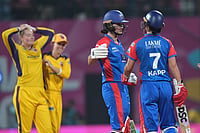A change is as good as rest, goes the English proverb, which implies that when things are not going your way, you need to do something different to turn the tide.
For Virat Kohli, who was unarguably the best all-format batsman in the world for at least five years on the trot, the last three years have been as difficult as they have been inexplicable.
In the small passages when he has made runs, and sometimes this has extended long enough to yield half-centuries, he has looked perfectly in control, even on top of his game. But just when his fans licked their lips at the prospect of that one big innings that would decisively turn the tide, he found a way to get himself out.
ALSO READ: Form Is A Mental Thing: Gautam Gambhir
Initially, there was a pattern, a tendency to extend himself outside the off stump to quick bowlers and edge behind the stumps. The data backs this up. Against quick bowlers, his line of dismissals shifted in direct correlation to his slump. On average, it was middle stump in 2019, 9 cm outside off in 2020, and 26 cm outside off in 2021.
This is a loud indication that a specific issue had crept into Kohli’s batting. With the resources available to him, it is inconceivable that he was not made aware of this. Why, as recently as July this year, a public offer came Kohli’s way.
“If I had about 20 minutes with him, I would be able to tell him the things he might have to do. It might help him, I am not saying it will help him but it could, particularly with regards to that off-stump line,” Sunil Gavaskar told the media. Gavaskar is the kind of batsman who could tell you where his off stump was if you woke him up in the middle of the night and was one of the best leavers of a ball the world has ever seen.
“It goes back to the fact that his first mistake turns out to be his last. Again, just because he is not among runs, there is this anxiety to play at every delivery, because that is what batters feel, they have got to score.”
Scrolling through Kohli’s various social media feeds, where you can even find him facing his wife, Anushka Sharma, in a fun game at one point during the lockdown, there is no evidence that this 20-minute session ever took place. Perhaps it did, behind closed doors, but we’ll never know.
If technical input was one option, there was another, more obvious one that came Kohli’s way. In April this year, Ravi Shastri, Kohli’s closest cricket confidante, the man whom the batsman trusts the most in the game, suggested that a break from cricket was in order. “I’m going straight to the main guy here. Virat Kohli is overcooked. If anyone needs a break, it’s him,” Shastri told Star Sports.
“Whether it’s two months or a month-and-a-half, whether it’s after England or before England. He needs a break because he has got 6-7 years of cricket left in him and you don’t want to lose that with a fried brain. If you’re going to be forceful, there is a very thin line there, from a guy losing the plot as opposed to him hanging in there and giving his best. So you have to be extremely careful.”
The fact of the matter is that Kohli, since the last ICC Twenty20 World Cup about 10 months ago, has got breaks from series or parts of series against New Zealand, Sri Lanka, South Africa, West Indies and now Zimbabwe.
With one Asia Cup to be played for fine-tuning team balance in pressure competitions ahead of a World Cup that is just months away, is it even possible for a batsman to regain form by not playing?
The obvious corollary to this question is that it may not be a matter of form after all. Rather, Kohli has gone from being the most important man in world cricket to a former captain in three formats in record time.
For this, Kohli must accept some of the blame when it came to decision-making. In September 2021, Kohli took to Twitter to announce that he was stepping down as captain of the Twenty20 International team after the World Cup that was just coming up, and that he would similarly let go of the Royal Challengers Bangalore leadership in the Indian Premier League, to give himself “space to be fully ready to lead the Indian team in Test and ODI Cricket.”
It was a gauntlet he threw down to the Board of Control for Cricket in India (BCCI) and their selectors, almost daring them to remove him from the 50-over captaincy. Kohli publicly stated that he wanted to lead India in the ODI World Cup at home in 2023.
Unfortunately for Kohli, his bluff was called, and even if versions differ on how exactly this happened, Chetan Sharma, the chairman of selectors, affirmed that they wanted to unify the white-ball captaincy, and Kohli was relieved of that job about a month after he quit T20 leadership.
If you join these two dots, you don’t have to look much further to January of 2022, when Kohli quit the Test captaincy in Cape Town after India fluffed their best chance of winning a maiden Test series in South Africa.
On no day more than this one did Kohli cut such a lonely figure. Here was a player who had the BCCI eating out his palms not long ago, the cricket world at large, especially pundits in England and Australia, hailing him the last man keeping the primacy of Test cricket alive, a coach who backed him up at every turn and a selection committee who allowed him to pick and drop the players he wanted, who suddenly had none of that.
If technical adjustments, rest, playing cricket and all combinations thereof have not helped Kohli break the jinx of not having scored three figures in any format since 2019, perhaps it is worth looking elsewhere.
Some players like to work in the background, putting up quiet runs or keeping the powder dry with quiet overs or keeping wickets impeccably, efficiently and inconspicuously. Kohli is none of these.
When he is on a cricket field, Kohli is used to being the centre of attention, the epicentre of the cricketing universe. When he had the bat in hand and was flaying the best attacks, it was impossible to take your eyes away from him. When he was captain, he changed fields constantly, berated teammates for failing to stop a ball and when nothing else was going on, played conductor and got the crowd moving on demand. Like Jim Carrey in The Truman Show, it appeared at times as though the entire cricket world was made up of actors and supporting cast just so that the cameras could film Kohli being Kohli.
And then, in a matter of months, this was gone. Kohli loosened the valve, but forces bigger than him quickly let out the oxygen that allowed him to pump himself up into the adversarial frenzy that made him the batsman he was.
There is no reason yet to believe that Kohli cannot get back to his best in Test cricket. There is a possibility that he could still have some leeway in 50-over cricket if the format hangs around long enough. In T20 Internationals, Kohli already feels surplus to requirement in a team looking to play a new brand of cricket and find the right balance to do so.
In that sense, the T20 World Cup in Australia could well be the last chance for Kohli in that format. Not long ago, it was Kohli who was calling the shots and rolling the dice. From the outside, it does not appear that there is any evidence that Kohli thrives in an environment that he is not in control of. And yet, because this is sport, and because he is Kohli, you never say never.
(This appeared in the print edition as "The Board Factor In Kohli’s Slump")
(Views expressed are personal)
Anand Vasu is an award-winning cricket journalist who has co-authored Cricket Drona-For the Love of Vasoo Paranjape.























